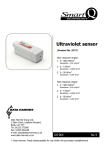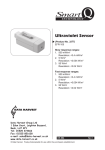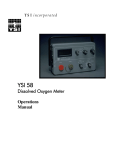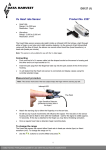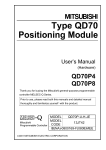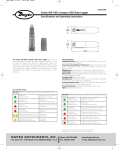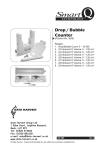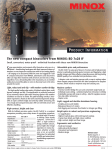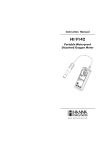Download Enter o to this page the details for the document
Transcript
Chemistry Sensors: Loggers: Drop / Bubble counter and ±1 V Voltage Any EASYSENSE Logging time: EasyLog Teacher’s notes 07 Potentiometric study of a mixture of halide ions Read In this investigation two half cells, one of a silver electrode in a solution of silver ions and a second of a silver electrode in a solution containing a solution of mixed halide ions are electrically connected by a salt bridge. The potential of the cell created should be close to the theoretical value +0.7 V. The potential across the cell will be monitored as a solution of silver ions is titrated into the solution of mixed halides. The silver ions will react with the halide ions and form the insoluble salts of the halides, as each halide is converted from its ion to its silver salt the potential across the cell will change. The potential across the cell will be reducing as the silver concentration in the second half-cell rises. When both half-cells contain the same concentration of silver, the potential across the cells will be zero. As each silver halide has a different solubility, there should be areas of stable potential followed by sharp falls in potential as the salt is precipitated out, the supply of the halide ions is exhausted, and the silver ion concentration can continue to rise. The Drop counter will measure the volume of the silver nitrate titrated, the quantity of silver ions added at any point can then be calculated. If the concentration of the silver ions being titrated into the halides is known the concentrations of the halide ions should be able to be calculated. The potentiometric titration of silver ions into a solution of halides is used by many water companies to find the concentration of chloride in the water supply. It is an accurate and reliable analytical method. The advantage of conducting this investigation with a data logger comes with the time saved in the analysis and with ability to set the investigation up and leave it running while background to the investigation can be covered. The ability of the software to create the first derivative, and if needed the second derivative as a method of finding the mid point should not be underestimated. Apparatus 1. An EASYSENSE logger. 2. A Smart Q ±1V Voltage sensor. 3. A Smart Q Drop / Bubble counter set to the correct volume range (see calibrating the Drop counter below) with alignment adapter fitted. 4. The drop counter reagent reservoir fitted with two stopcocks and tip. 5. Magnetic stirrer and follower. 6. Salt bridge 7. 2 x 250 ml beakers. 8. 50 cm3 0.1 mol dm-3 silver nitrate (AgNO3). L3 Chemistry T07 - 1(V2) 9. Solution of mixed halides (solution X). 10. Distilled and deionised water. 11. Clean, untarnished silver foil electrodes (approx 4 cm long by 1 cm wide). 12. Small beaker. Set up of the software and logger Use EasyLog to record the data, the time taken to reach the end point is uncertain. In the test experiments times in excess of 30 minutes were recorded. Notes Hazard information for Silver nitrate Caution, Handle with care Oxidising agent • Silver nitrate is a powerful oxidising agent and care should be taken to avoid contact with skin. • Silver nitrate should be handled with care and stored carefully. MSDS instructions from the supplier will give more detailed information and local safety rules or advice should be adhered to. The advice from SSERC or CLEAPS in the UK should be followed, unless contradicted by local safety advice. Solutions Solution X, which will go into beaker K, is made up of a mix of potassium salts, KBr, KCl and KI. Use something in the order of 0.56 g of KCl, 0.99 g of KBr and 1.22 g of KI. The quantity is not important, but you do need to record the mass used for molar calculations. The values suggested do not have simple molar values. The salts should be dissolved into 200 cm3 of distilled and deionised water. The students will take 20 cm3 of this stock and make it up to 200 cm3 for the half-cell. The silver nitrate needs to be made accurately; it may be worth considering buying this solution already prepared. Each investigation will need approx 60 cm3 in total. The students will take 20 cm3 of the silver nitrate and make it up to 200 cm3 to make the silver nitrate solution for beaker L. When using the silver solution you must use distilled and deionised water to prevent formation of silver salts (especially be aware of chloride). Setting up the half cells The half-cells are best made up in 250 ml capacity glass beakers. The silver foils can be soldered to a wire. If the wire is passed through a glass tube, the glass tubing can be used to hold the electrodes in position. The foils need to be clean of any oxidation or tarnish; rubbing with a fine emery paper will clean the surface well. Polish is not advised as protective lacquers may be deposited by the polish. The electrodes should be positioned to make sure the soldered joint or the contact between the silver and the conductor wire does not become covered by either solution. The salt bridge between the two half-cells is made from potassium nitrate in gelatine to fill a U tube. Make sure the U tube will make contact with both solutions. Consider the height differences when the solution K is up on a magnetic stirrer. L3 Chemistry T07 - 2(V2) An alternative to the gelatine salt bridge is to use filter paper strips soaked in the nitrate solution or use cotton or nylon cord. The paper cord bridges work as well as the gelatine bridge, but with stirring the ends of the bridge may become damaged. Calibrating the Drop counter This investigation uses the Drop counter with one of its preset calibrated ranges e.g. 27 drops/cm3 so the drops counted are automatically converted and displayed as volume in cm3. See the Drop counter user manual. If accuracy is not critical and you are using the reagent reservoir and tip supplied with a low viscosity liquid (like water) and the flow rate set to: • Fast e.g. 10 plus drops per second, use the 24 drops/cm3 range. • Medium e.g. between 5 – 10 drops per second, use the 25 drops/cm3 range. • Slow e.g. between 1.5 – 5 drops per second, use the 26 drops/cm3 range. • Very Slow e.g. less than 1.5 drops per second, use the 27 drops/cm3 range Results and analysis The analysis of the data from this practical is moderately complex. A sample set of data has been included to allow calculations to be followed. The a dx/dt function can be applied to the voltage data to produce a first derivative curve. Any slight variations in the graph will be exaggerated by applying a function. Select Smoothing (Tools menu) and smooth the data by no more than 3 units. From the Tools menu select Post-log Function. Choose the formula function a dx/dt and set the following parameters as they are asked for in the wizard: • • • • • • • x = Voltage sensor a = 10 (this is a multiplier, as calculated the peaks produced may be small. Using the multiplier provides peaks that can be easily seen and used – you may have to use different multipliers or use Autoscale) Number of decimals = 4 Max = 10 Min = 0 Name = Rate of change Units = DmV The first derivative plot should reveal three well defined peaks as illustrated in the example data shown below Voltage (mV) 700 600 500 400 300 200 100 0 19m 28s L3 Chemistry T07 - 3(V2) Time 38m 56s Use Values to intersect the voltage and volume lines at each peak, the readings from the sample data at these points was: Peak number Voltage (mV) Volume of AgNO3 (cm3) 1 550 10.70 2 352 23.56 3 166 33.07 The derivative allows us to find the steepest part of the slope, which corresponds to the removal of effectively all of the ions of each species. The first step is removal of iodide, the second step bromide and the last chloride ions. The number of moles of Ag+ used to precipitate all of the iodide ions from the 20 cm3 of the solution X added to beaker K is equal to; Calculation 1 (Volume of silver nitrate used x molarity of the silver nitrate) / 1000 Using data from the table above, (10.70 x 0.1) / 100 = 0.00107 moles The moles of Ag+ = the moles of IThe moles of I- per litre of solution = Calculation 2 (Volume of litre / volume used) x the moles calculated from Calculation 1 (1000 / 20) x 0.00107 = 0.0535 mol dm-3 The process is completed for each peak to find the concentration in mol dm-3 for Br- and Cl-. The mass of the halide salts should be recorded and converted into the mol dm-3 for comparison, remember the halides are dissolved into 200 cm3 of distilled water when doing the calculation. Extension During precipitation of any silver halide, the product of the silver ion and the halide ion concentrations will be equal to the solubility product of the silver halide. As the halide ion concentration falls, the silver ion concentration must rise. The solubility product can be calculated using values calculated and derived from the experimental data. Step 1 Calculate the concentration of the halide ion when half of them have been precipitated. To do this take the molar concentration value calculated above and simply divide by 2. Express as an exponential value (e.g. 1.0 x 10 –3). From the data supplied this will be 0.0535 / 2 = 0.0267 = 2.675 x 10-3 L3 Chemistry T07 - 4(V2) Step 2 Using the data collected find the mid point of the first step and record the voltage at the mid point. Use the voltage reading as volts and not millivolts. From the data supplied above, 550 mV = 0.550 V Step 3 L = the beaker with the silver / silver nitrate half cell K = the beaker with the mixed halides. Emeas is the voltage at the mid point. The molarity of the original silver solution is 0.1 mol dm-3 which is 10-2 mol dm-3. The electrode potential for the silver / silver half-cell is calculated at 0.058 lg [Ag ] + The measure emf of the cell is represented by the equation; Emeas = 0.058lg [ Ag + ]L [ Ag + ]K E 10−2 = meas lg + [ Ag ]K 0.058 lg 10−2 0.550 = = 9.5 + [ Ag ]K 0.058 10 −2 = 109.5 [ Ag + ]K [Ag+]K = 10-11.5 Step 4 Convert the answer in step 3 to a non log format. [Ag+]K = 10-11.5 = 3.16 x 10-12 Multiply this answer by the step 1 answer to give the solubility product. 3.16 x 10-12 x 2.675x10-3 = 8.45 x 10-15 Similarly, it can be calculated for the bromide and chloride ions. L3 Chemistry T07 - 5(V2)





